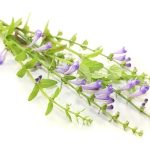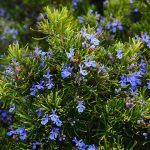Forskolin is a key active ingredient from the root of Plectranthus forskohlii (syn. Coleus forskholi ) which predominantly grows in India, Nepal and Thailand. It is a perennial plant of the Lamiaceae (mint) family and the many properties of the components in the plant have been reviewed (Lakshmanan et al., 2013).
Considerable interest in natural supplements for fat burning and healthy weight loss has led to a spate of interest in these types of products. Forskolin is as yet an unregulated plant product which deserves further attention.
The concoctions of the roots of Plectranthus forskohlii are used to treat a range of conditions such as asthma, glaucoma and heart disease. Weight loss has become a recent focus of attention.
Forskolin (7 -Acetoxy-8, 13-epoxy-1, 6, 9-trihydroxy-labd-14-ene-11-one) is a diterpene in the labdane family of chemicals and was first isolated from the roots in 1974. It activates adenylate cyclase in ‘in vitro’ cell preparations which produces a rise in intracellular cyclic AMP in the cell. The underlying biochemical basis is thought to help potentiate hormone responses and was first examined back in the late 70’s and early 80’s (Seamon & Daly, 1980). There are some excellent reviews on this molecule in biochemical terms (Daly, 1983; Seamon & Daly, 1986).
Cyclic AMP promotes the breakdown of stored fats in animal and human fat cells. The action of forskolin was examined in hamster adipocytes giving clues as to how it might promote fat burning for example (Schimmel, 1984).
Clinical Studies
Few high quality human studies have shown supplementation with either C. forskohlii extract or forskolin itself have produced favourable changes in body composition. A study in 2005 by Godard et al., (2005) found improvements in body weight loss in obese men in what was a relatively small study but set a marker for forskolin action.
Word Of Caution
The safety and efficacy of forskolin has yet to be fully established although there is research underway to define acceptable limits. There are no defined guidelines and one of the main issues to overcome is the quality of the extracts on offer which all appear to provide varying levels of active ingredients.
References
Daly, J. W. (1983). Forskolin, adenylate cyclase, and cell physiology: an overview. Advances In Cyclic Nucleotide And Protein Phosphorylation Research. 17, pp. 81-89
Godard, M.P., Johnson, B.A., Richmond, S.R. (2005) Body composition and hormonal adaptations associated with forskolin consumption in overweight and obese men. Obes. Res. 13, pp. 1335–1343.
Lakshmanan, G.M.A.; Manikandan, S.; Panneerselvam, S. (2013) Plectranthus forskohlii (Wild) Briq. (Syn: Coleus forskohlii)—A compendium on its botany and medicinal uses. Int. J. Res. Plant Sci. 3, pp. 72–80.
Litosch, I., Hudson, T.H., Mills, I., Li, S.Y., Fain, J.N. (1982) Forskolin as an activator of cyclic AMP accumulation and lipolysis in rat adipocytes. Mol. Pharmacol. 22 pp. 109-15.
Seamon, K. B., & Daly, J. W. (1980). Forskolin: a unique diterpene activator of cyclic AMP-generating systems. J. Cyclic Nucleotide Research, 7(4), pp. 201-224.
_______________________(1986) Forskolin: its biological and chemical properties. Advances In Cyclic Nucleotide And Protein Phosphorylation Research. 20, pp. 1
Schimmel, R.J. (1984) Stimulation of cAMP accumulation and lipolysis in hampster adipocytes with forskolin. Am. J. Physiol. 246, C63–C68.


Leave a Reply